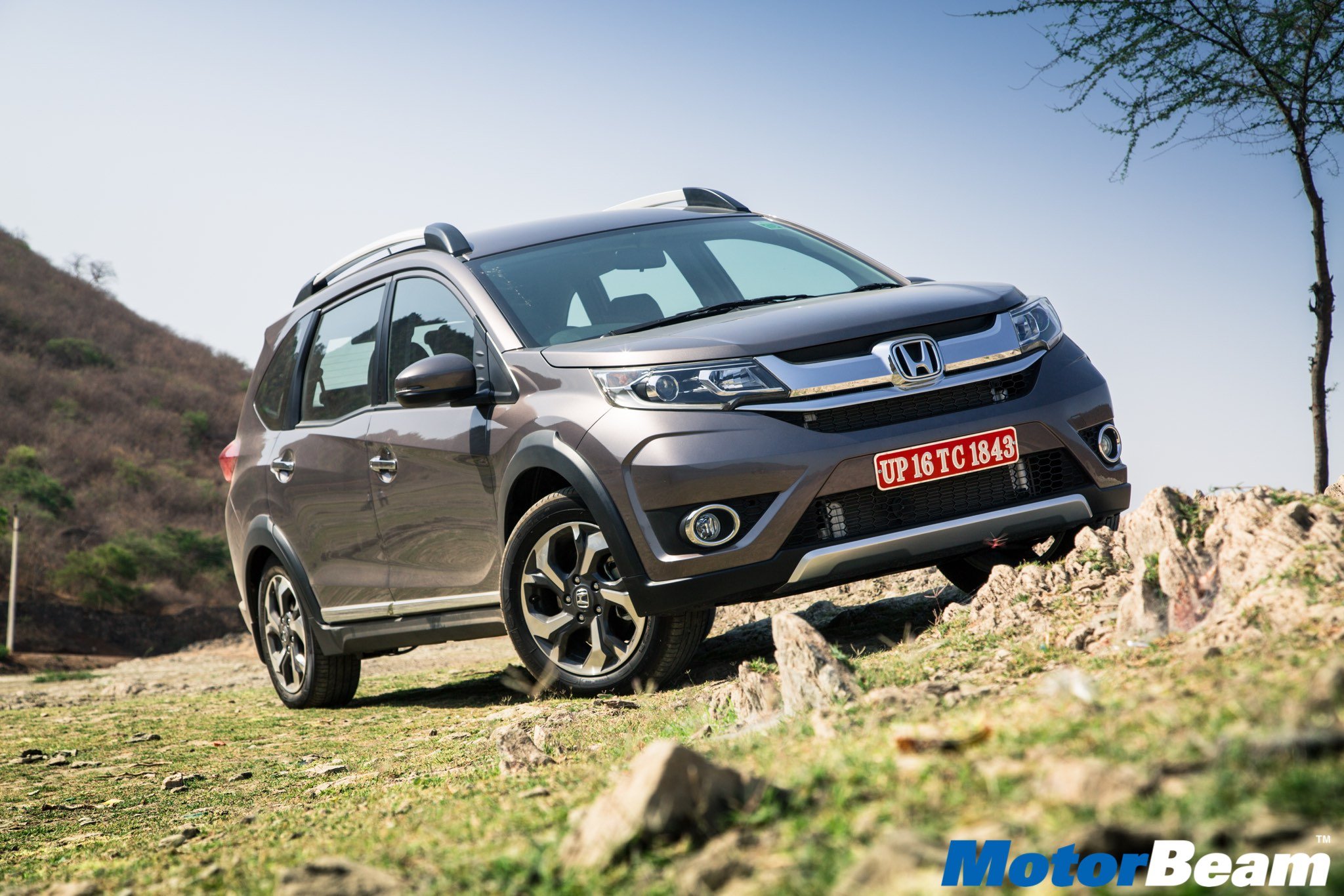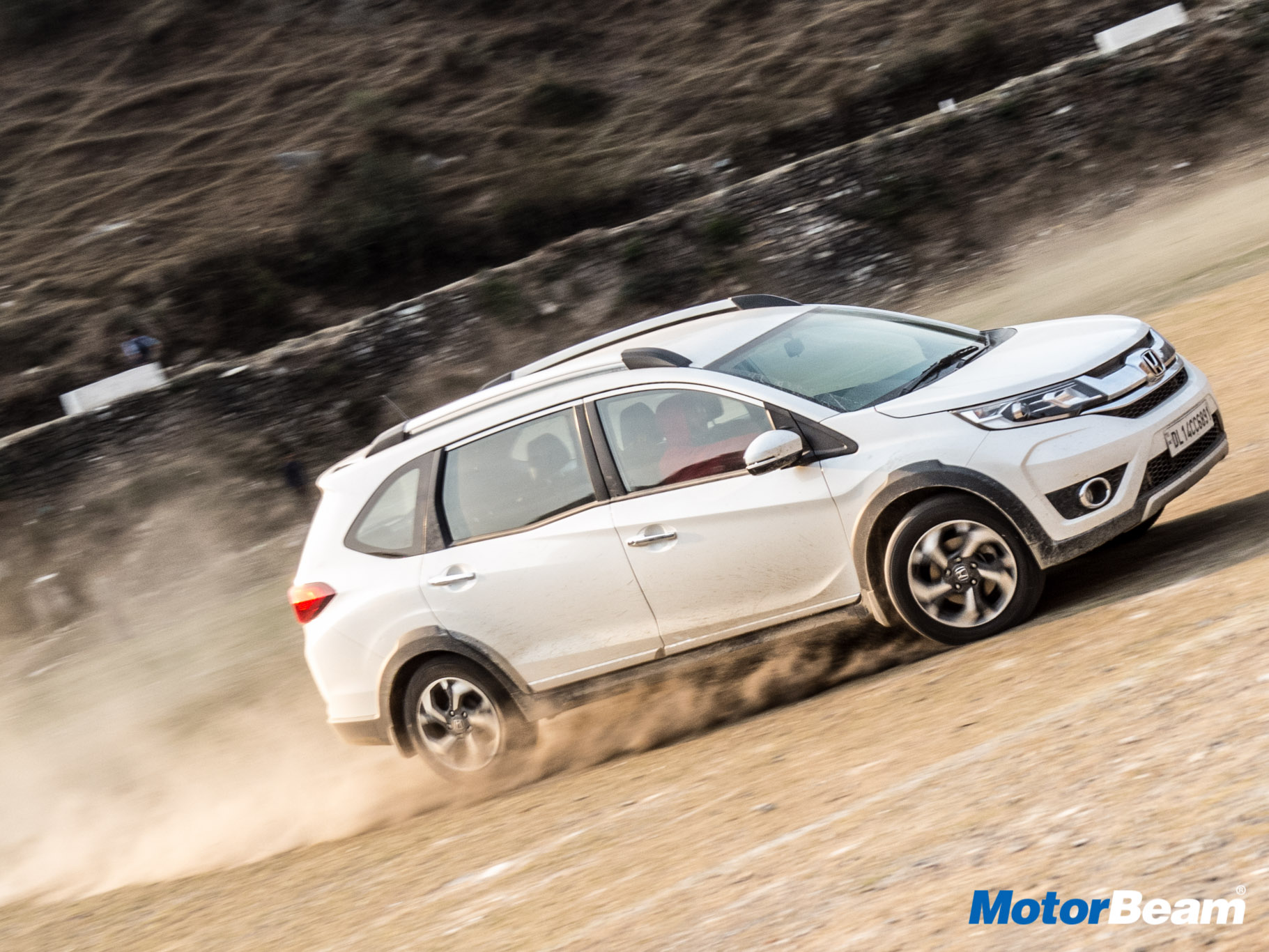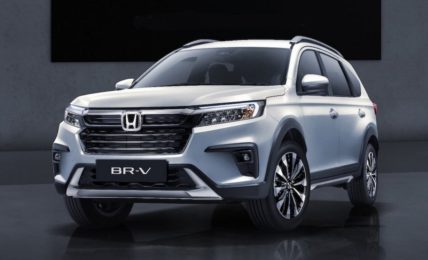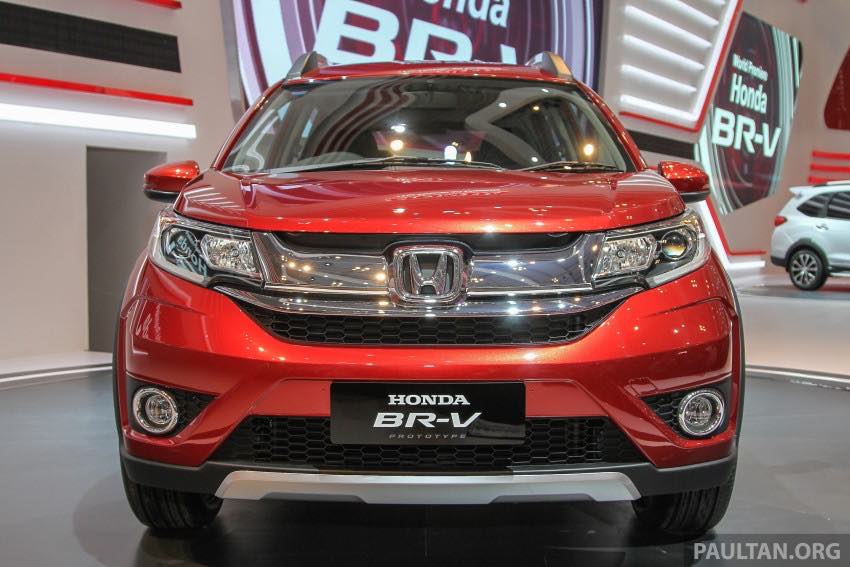
Honda BR-V Review
Car Tested: 2016 Honda BR-V; Road Test No. 695
Price OTR Mumbai: Rs. 10.38 – Rs. 15.66 lakhs
The Honda BR-V offers a unique experience of a practical 7-seater compact SUV in its segment
India is currently the fifth largest automobile market in the world and is estimated to be the third largest in the next four years. Despite the economic downturn, the automobile industry is showing growth. In order to keep costs in check, manufacturers have developed platforms which can accommodate numerous models. Now, with the SUV craze at its peak, Honda decided to bring in the BR-V, a crossover based on the Brio Platform (Mobilio) and will compete in the compact SUV segment.
Motor Quest: Honda shifted focus to the volume market with the launch of the Brio hatchback. It then launched the Amaze and Mobilio on the same platform. With the SUV segment showing some astonishing growth, the BR-V was conceived as a crossover which will compete with the likes of the Renault Duster and Hyundai Creta. It is heavily inspired by the Mobilio.
The BR-V looks like an updated Mobilio from the side profile
Exteriors – The Honda BR-V belongs to the Brio family as the compact SUV is based on the same platform. However, the BR-V is the first car from the Brio lineup to break the mundane styling cues. It has got a heavily revised front, spruced up side profile and a new look for the rear. The projector headlamps are sleek and chunky, merging with the signature Honda chrome grille seamlessly. The front bumper is brawny getting some nice styling details along with a faux silver skid plate and an upright hood for that SUV stance. The front three-quarters of the BR-V manages to exhibit the SUV look but as you go towards the side profile, things are quite different.
The rear looks premium and polished thanks to the unique tail lights
The BR-V’s design is a mixed bag, SUV from some angles but MPV from many
The Honda BR-V resembles the Mobilio MPV to a large extent when viewed from the side angle. It has got the same kink on the B-pillar, roofline is identical and the lengthy MPV silhouette is quite visible. Honda has given it some rugged details for making it look a bit SUVish and these include tall roof rails, 210 mm of high ground clearance and black cladding on the lower half of the body. The rear has got some eye catching elements such as the new LED tail lamps with a long reflector panel connecting the cluster which gives it a wide look. There is chrome garnishing on the tailgate and a skid plat for the rear bumper. The overall design looks more MPV oriented rather than being an upright SUV.
New interior details with the 3-spoke steering looks good on the BR-V
Interiors – The Honda BR-V shares some components with its siblings such as the new dashboard that we saw first on the Amaze facelift. The three-spoke steering wheel is borrowed from the outgoing Jazz that feels good to hold and offers controls for the audio system as well as paddle shifts for the CVT variant. The instrument cluster is 3D, which is borrowed from the new City and it looks quite nice to read having a sizeable MID display showing trip meter, range, average fuel consumption, instant fuel consumption, time and ambient temperature. Sadly the BR-V comes with a tiny screen and there is no touch screen infotainment system, no rear parking camera and no rear parking sensors as well, which is quite shocking for a car this big. However, the good thing is that the Bluetooth audio system with telephony comes standard across all the variants except the base trim.
The legroom and headroom is ample for tall passengers
The interior feels even more spacious loaded with features & looks stellar
The Honda BR-V is offered with an automatic climate control system, which we didn’t see in the Mobilio. It works quite well along with the rear AC vents, both of which are standard on offer excluding the E variant that comes with a manual AC. There are generous amount of cubby holes to keep the cabin neat and tidy. It comes with two cup holders for the front passengers, bottle holders on all door pockets and cupholders for the third row passengers as well. The BR-V offers an all-black leatherette upholstery which feels quite good and is comfortable. The seats are supportive up front and there is great legroom for the second row passengers including good headroom but shoulder room is a bit tight since the BR-V is narrow.
There is generous amount of space with the third row up
The second row of seats can be slided forward and backward and are reclinable too. The third row is best used for two kids but average sized adults can also fit in since there is decent amount of legroom but under-thigh support is lacking. The best part about the Honda BR-V is its flexible seating and storage capacity. The second row seats offer one touch tumble along with 60:40 split. The third row seats can be fully tumbled and offer 50:50 split and still you have enough room for cargo even if all rows are up. The BR-V offers 223 litres of boot space when all three rows are up and 691 litres when third row is folded. Some of the key features include projector headlights, heat absorbing windshield, keyless entry with push button start, power foldable ORVMs, auto AC and more.
The diesel engine has negligible turbo lag and good drivability
Performance – Powering the BR-V are the same engines which sit under the hood of the Mobilio. The diesel oilburner delivers similar power output of 100 PS at 3600 RPM and torque of 200 Nm at 1750 RPM. This engine is mated to a 6-speed manual transmission (derived from the City). However, the gear ratios have been reworked to suit the BR-V. While the first five gears have the same ratio, the sixth gear is shorter by 7.7% for better SUV performance.
The NVH level is better but vocal at higher RPMs
The 6-speed manual transmission offers better drivability while the CVT offers convenience while driving in the city
There is negligible turbo lag after which performance is quite linear. Even with four people in the car and some heavy camera equipment, the Honda BR-V never felt underpowered. Low-end performance is much better now and Honda has added some insulation to the engine compartment thereby making the NVH levels mildly better in the cabin but this engine is far from being the quietest in the segment, getting quite vocal in the higher end of the rev band. The ARAI certified fuel economy is 21.9 km/l, we reckon it should return around 14 km/l in the routine driving cycle.
The CVT is convenient for city usage paired with a petrol engine
The petrol too is the same 1.5-litre i-VTEC unit and this engine churns out 119 PS at 6600 RPM and a maximum torque of 145 Nm at 4600 RPM. This powerplant comes with an all new 6-speed manual gearbox and a segment first petrol CVT. This manual transmission has been optimised for the BR-V by lowering the first gear ratio by 12% while the top gear ratio has been increased by 7%. The manual variant has an ARAI certified fuel economy of 15.4 km/l, it should return around 11 km/l in the regular driving cycle.
The engines are fuel efficient for a vehicle this size
We had a small run in the petrol CVT version at the drive. Honda has reduced the weight as well as the friction for the CVT in order to get better performance and fuel efficiency. The CVT feels quite good for city driving offering the comfort and convenience of an automatic. However, it is only when you give it the beans that it gets quite noisy with a pronounced rubber band effect. In theory, this CVT is more fuel efficient than the manual at 16 km/l.
The BR-V offers predictable handling and the steering feel is good too
Driving Dynamics – The BR-V has higher ground clearance and this has rendered it some amount of body roll, but it is well within the limits. On the other hand, higher ground clearance makes it apt for our road conditions. Bad, broken roads and those usually high speed humps don’t intimidate the BR-V at all. The steering feel is good and it weighs up well with very predictable handling, the diesel feeling better than the petrol. Ride quality is quite mature but it gets a little bouncy on bad roads, especially at low speeds. At high speeds, the ride is more sorted. We did take the BR-V off tarmac on many occasions and it felt upto the task most of the times. Brake bite is quite good and the Michelin tyres on our test car did the job quite well.
Honda has a wide service network and a trustworthy after sales
Safety and After Sales Service – Honda is offering dual front airbags and ABS as standard across all the variants except the base E petrol version of the BR-V. It is a good move but considering the marginal price increase with ABS, they should have offered it on the base petrol trim. None of the cars from the Brio family have been crash tested by Global NCAP so we can’t judge the structural strength of the BR-V yet. However, the after sales of Honda is quite trustworthy and low on maintenance, which is a boon for Indian buyers. The Japanese automaker currently has 298 outlets across 190 cities in India and they plan to ramp it up to 340 outlets by March 2017.
The Honda BR-V is a practical compact SUV with bold styling
Verdict – The BR-V offers what most people in this segment look out for, bold styling with SUV elements and the ability to seat 7 people. The BR-V is currently the only option out there which offers this flexibility. It offers good cabin room with respectable performance from both the petrol and diesel engines. Though the MPV silhouette is quite reminiscent of the Mobilio (which could be a deal breaker) the Honda BR-V makes good sense for those who want a compact SUV with oodles of practicality.
The high ground clearance makes it a boon on Indian roads
What’s Cool
* New dashboard design and layout looks fresh and is practical
* All-black interiors of the BR-V give it a premium yet sporty feel
* Front styling is bold as the design cues are sharp
* First in segment 7 seats adds to the practicality of this compact SUV
* The petrol engine is quite potent and offers good drivability
* Dual airbags standard across all variants
What’s Not So Cool
* MPV profile, especially when you look at it from the side, too much similarity to the Mobilio
* The 1.5-litre i-DTEC diesel engine is noisy
* Honda has no plans to introduce a diesel automatic version of the BR-V
* Rear camera and parking sensors are a big miss
Alternatives: Hyundai Creta, Renault Duster
This is the best angle to look at the Honda BR-V
Honda BR-V Specifications
* Engine: 1497cc, i-VTEC, 16V, 4-cylinder, SOHC | 1498cc, i-DTEC, 16V, 4-cylinder, turbocharged, DOHC
* Power: 119 PS @ 6600 RPM | 100 PS @ 3600 RPM
* Torque: 145 Nm @ 4600 RPM | 200 Nm @ 1750 RPM
* Transmission: 6-speed manual, CVT | 6-speed manual
* 0-100 km/hr: 12 seconds | 15 seconds (est.)
* Fuel Consumption: 10 km/l | 15 km/l
* Fuel Type: Petrol | Diesel
* Suspension: McPherson Strut (Front), Torsion Beam (Rear)
* Tyres: 195/60/16
* Brakes: Disc (front), Drum (rear) ABS
* Safety: Dual Airbags, ABS, EBD
Honda BR-V Dimensions
* Overall length x width x height: 4456 mm X 1735 mm X 1666 mm
* Wheelbase: 2662 mm
* Ground clearance: 210 mm
* Turning radius: 5.5-metres
* Fuel Tank Capacity: 42-litres
* Kerb Weight: 1306 kgs
It will be interesting to see how it fares in the competitive segment
Further Reading –
Honda BR-V Video Review
Honda BR-V First Drive Review




